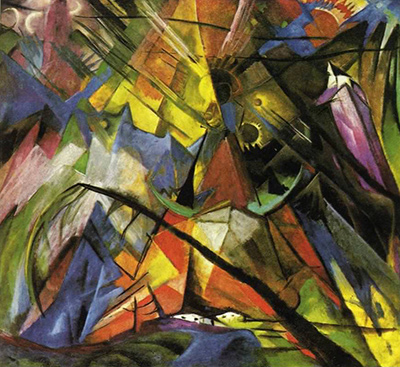Tyrol is one of the final pieces painted by Franz Marc before his death at the age of 36 during the Battle of Verdun, one of the bloodiest battles of WWI
This painting, created in 1913, along with other famous Marc paintings of that year, Fate of the Animals, and The Tower of Blue Horses, is a dark departure from his earlier works.
Absent here are the sweet sleeping cats from paintings such as Cat on a Yellow Pillow. Gone is the spiritual, child-like innocence of Franz Marc's blue horses. Tyrol, like Fate of the Animals, is apocalyptic, portraying a sense of doom, perhaps partly due to the oncoming war.
Tyrol is a scene of cataclysmic destruction. The heavens above have parted. Crumbling mountains rain down destruction and ruination on the defenceless village below.
Two small, white cottages sit nestled on the hills at the base of the mountain, dead trees standing next to them as they await their fate. A black tree hangs in the foreground, eerily resembling a sickle in its shape.
It's a stark scene that shows a clear and dramatic shift in Marc's work at that time. As this shift was taking place, the same can be said for Marc's view of animals.
While he once saw animals as pure, and representative of a more innocent time, he lost that sense of empathy as the war loomed ahead. His feelings became conflicted, stating that he had seen the repulsive and ugly sides of nature.
He believed, at this time, that perhaps the war would have a cleansing effect on the natural world, and that it would regenerate after the destruction.
These dark feelings of disenchantment and inner conflict come through in this devastating scene portrayed in Tyrol.




